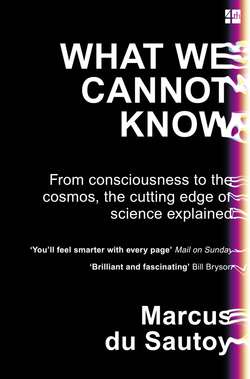Читать книгу What We Cannot Know: Explorations at the Edge of Knowledge - Marcus Sautoy du - Страница 51
THE NEXT LAYER
ОглавлениеEven when Thomson used a different metal, the masses of particles emitted by the metal didn’t change. It seemed like every atom had these particles as constituents. The first thought was that a hydrogen atom, given that it is 2000 times heavier than this new electron, might be made up of 2000 or so of these electrons. But a helium atom was roughly four times the mass of a hydrogen atom. Why would the number of electrons jump from 2000 to 4000 with nothing in between? This whole-number ratio between masses of atoms in the periodic table had been one of the reasons for supposing they were truly atomic. So what could account for these discrete steps in mass? Furthermore, atoms were electrically neutral. So were there other particles that cancelled out the charge on the electron? Could you get atoms to emit positive particles to counter these negative electrons?
There was actually evidence in the experiments for a positive ray of particles running in the opposite direction. When a magnetic field was applied, they were much harder to deflect, implying that they were more massive than the electrons. The curious feature this time was that the masses of these particles seemed to vary according to the gas that was being used to fill the tubes. For hydrogen the mass was essentially the mass of the atom you started with. It seemed that the hydrogen atoms in the tube were having their electrons stripped off, leaving a large positive particle that was then attracted to the opposite electrode.
Thomson managed to achieve a similar effect with other gases: helium, nitrogen, oxygen. The masses were all whole-number multiples of the positive particle produced by the hydrogen atom. Atomic harmony yet again. As yet, there was no reason to believe that there weren’t just many sorts of positive particles, just as there were many sorts of atoms. Thomson had suggested a model of the atom known as the plum pudding. The positively charged part of the atom, which was more massive than the negative electron, formed the pudding making up the bulk of the atom, while the electrons were the tiny fruit inside.
Then the age of the bombardment of the atom began which would eventually lead to the ultimate atom smasher: the Large Hadron Collider at CERN. The New Zealand-born British physicist Ernest Rutherford is generally credited with the discovery of the proton, the particle that was the building block for all these positive particles that Thomson had investigated.
Rutherford became fascinated by the new subject of radioactivity. Uranium atoms seemed to be spitting out particles that could be picked up by photographic plates. There appeared to be two types of radiation, and these became known as alpha particles and beta particles. The alpha particles were more easily detected. Rutherford found that using a magnetic field he could deflect these alpha rays in the same way that Thomson had deflected the negative particles. Calculations showed that they had the same mass as the stripped helium atoms. Their hunch that the alpha rays being emitted by the uranium were actually bits of helium atoms was confirmed when the alpha rays were combined with a shower of electrons, which resulted in a stable gas being formed. Chemical analysis soon confirmed that the gas was indeed helium.
